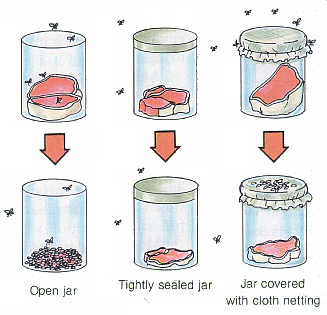
Redi experiment
(1665)
As late as the 17th century, some
biologists thought that some simpler forms of life were
generated by spontaneous generation from inanimate
matter. Although this was rejected for more
complex forms such as mice, which were observed to be born
from mother mice after they copulated with father mice,
there remained doubt for such things as insects whose
reproductive cycle was unknown. [An important step was the
documentation by Maria
Sibylla Merian (1647 - 1717) of the stages of
metamorphosis in butterflies].
To test the
hypothesis, Francesco Redi placed
fresh meat in open containers [left, above]. As expected, the
rotting meat attracted flies, and the meat was soon swarming with
maggots, which hatched into flies [left, below]. When the jars
were tightly covered so that flies could not get in [middle, above], no maggots
were produced [middle, below]. To answer the objection that the
cover cut off fresh air necessary for spontaneous
generation, Redi covered the jars with several layers of porous
gauze [right, above] instead of an air-tight cover. Flies were
attracted to the smell of the rotting meat, clustered on the
gauze, which was soon swarming with maggots, but the
meat itself remained free of maggots [right, below]. Thus
flies are necessary to produce flies: they do not
arise spontaneously from rotting meat.
Redi went on to demonstrate that dead maggots
or flies would not generate new flies when placed on
rotting meat in a sealed jar, whereas live maggots or flies
would. This disproved both the existence of some essential
component in once-living organisms, and the necessity of fresh
air to generate life.
Note that is unnecessary to observe or even
imagine that are such things as fly eggs, nor
does the experiment prove that such exist. Redi's experiment
simply but effectively demonstrates that life is
necessary to produce life. Redi expressed this in
his famous dictum as "Omne
vivum ex vivo" ("All life comes from life").

